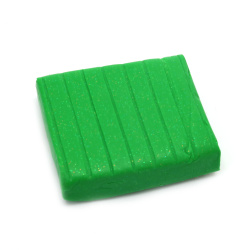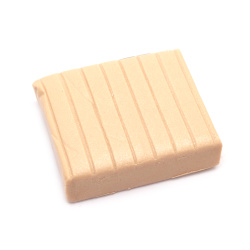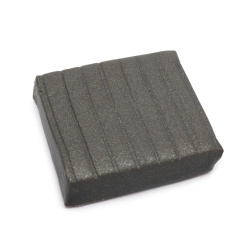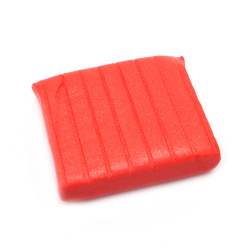Polymer Clay & Air-Dry Modeling Clay for DIY Crafts
We offer two types of modeling clay: self-curing and polymer clay for baking. The DMO polymer is available in a rich color palette, while the self-drying, which also reaches great strength after drying, is white or reddish brown. We offer 2 brands DAS and DOZEN. Our goal is to keep you competitive and competitive, so don’t hesitate to order from us.
View more
Air-Dry Clay with Tools and Instructions, Assorted Colors - 6 Colors x ~38 grams

Air-Dry Clay Assorted Colors in a Tub - 5 Colors x ~26 grams

MONT MARTE Make n Bake Polymer Clay, 400g - Sunflower

Make n Bake Polymer Clay MONT MARTE, 400g - Scarlet

Polymer clay neon green-brown - 50 grams

Polymer clay color pearl dark gray - 50 grams

Polymer clay color pink-purple with hologram brocade - 50 grams

Polymer clay color metallic green - 50 grams

Polymer clay color black with hologram brocade - 50 grams

Polymer clay color green with hologram brocade glitter - 50 grams

Polymer clay color yellow with hologram glitter / brocade - 50 grams

Polymer clay neon green dark color - 50 grams

Polymer clay neon green light color - 50 grams

Polymer clay color pearl blue-green light - 50 grams

Polymer clay color pearl brown - 50 grams

Polymer clay color beige with brocade - 50 grams

Color Pale blue polymer clay with brocade - 50 grams

Color Light blue Polymer clay with brocade - 50 grams

Polymer clay light peach color - 50 grams

Polymer clay color TEAL - 50 grams

Light pink polymer clay with Holographic brocade/glitter - 50 grams

Polymer clay color red with brocade - 50 grams

Polymer clay color pearl cyclamen - 50 grams

Polymer clay color pearl gray - 50 grams

Polymer clay color gray with brocade - 50 grams

Polymer clay metallic orange - 50 grams

Polymer clay color metallic red - 50 grams

Purple polymer clay with hologram brocade - 50 grams

Orange-red polymer clay with hologram brocade/glitter - 50 grams

Polymer clay color metallic blue - 50 grams

Polymer clay color pearl light blue - 50 grams

Light blue polymer clay with hologram brocade - 50 grams

Polymer clay aquamarine pastel color - 50 grams

Polymer clay color pearl purple - 50 grams

Polymer clay, Color Cobalt blue - 50 grams

Pearl green polymer clay - 50 grams

Polymer clay neon color cobalt blue - 50 grams

Polymer clay color pearl green light - 50 grams

Polymer clay, color pearl red - 50 grams

Polymer clay, color pearl pink - 50 grams

Polymer clay, color pearl orange dark - 50 grams

Polymer clay, color pearl orange - 50 grams

Polymer clay pearl yellow color - 50 grams

Polymer clay color black with brocade - 50 grams
Videos in the channel of EM ART
Cup decoration
How to decorate a glass yourself with polymer clay from EM ART?
Clay and Polymer Clay for All Your Creative Projects
For fans of applied arts, we have prepared high-quality clay. Clay is a natural material made up of ground aluminum silicates. Its normal state is powdery, but when moistened, it acquires a consistency similar to plasticine.
When mixed with water, clay becomes pliable and easy to work with. It is the primary material in the production of tiles, bricks, and ceramics.
Types of Clay
1.Natural Clay
Clay is a natural mineral. Its normal state is powdery, and it becomes plasticine-like upon moistening. It is categorized into two colors – brown and gray.
Clay is usually baked in an oven. Baking is a very specific step in the process of working with clay.
The baking begins significantly before the melting point. Those of you who have decided to choose this material need to know its specifics.
Clay is mainly used for making jewelry that requires baking. Various washers and jewelry elements are made from it. Some jewelry makers prefer to work specifically with this material because of its durability and looks.
Clay elements can be colored in various hues. Use special ceramic paints for this purpose.
Polymer clay offers a convenient alternative for those who may not have the time to engage in traditional baking or work with regular clay.
2.Polymer Clay
Polymer clay is one of the greatest innovations of our time.
It is the most widely used material among applied arts enthusiasts.
Polymer clay is made from ground paper pulp, with added desiccant. It’s suitable for modeling and making jewelry, sculptures, children’s toys, and dolls. It can be used to make baby’s handprint or footprint keepsakes.
Working with polymer clay is a pleasant, interesting, and easy process:
Cut the necessary amount of clay and model with wet hands. Bake the finished piece in an oven at about 110°C. Store the remaining material in a cool, ventilated place.
After baking, the clay can be colored with markers, tempera, or acrylic paints. This material is suitable for both adults and children over 3 years old. It’s one of the most popular products for family fun.
Applications of Polymer Clay
Polymer clay is one of the most convenient and preferred materials for making jewelry. With it, you can recreate various figures – flowers, animals, insects, angels, etc.
Using silicone molds and casting molds, you can create various jewelry pieces – flowers, animals, geometric shapes, and many others.
Polymer clay is the most used material for making jewelry because it has very vibrant colors that make the decorations created from it look incredibly beautiful. If you use uncolored, air-dry clay, you can color it any way you want.
Besides jewelry, polymer clay is also used for making cups because it allows for easy processing. The end result: exceptionally beautiful and original cups, which would be a truly beautiful and unforgettable gift.
What Do You Need?
To start working with polymer clay, you will need cutting tools, modeling tools, as well as cutting boards and bead trays.
Polymer clay allows endless creativity. You can make many colorful jewelry pieces in various shapes.
If you haven’t tried it yet, check online for ideas. There’s also lots of photos online from which you can also draw ideas. There are many tutorials for working with polymer clay that you can definitely trust.
Plasticine
The other widely used material for making various shapes is modeline, also called plasticine.
Plasticine is also a modeling material. It’s made from purified and finely ground clay, with added fat, wax, and other substances to prevent the material from drying out.
Today, modern versions of plasticine are made from high molecular weight polyethylene (HMWPE), PVC, silicone, rubber, and other high-tech materials. It comes in a wide variety of hues.
What Can You Do with Plasticine?
Plasticine is children’s favorite material for play. Working with it develops a sense of aesthetics, improves motor skills, and sparks imagination.
There is also air-dry plasticine. It works the same way.
Children enjoy playing with plasticine, which helps improve their fine motor skills. They can shape their favorite animals and objects using their hands and keep their creations as keepsakes for years to come.
If you want to preserve the figures your children have created for a long time, air-dry plasticine is ideal for that.
The Similarities and Differences Between Clay and Plasticine
Clay and plasticine look similar but also significantly differ in the way you work with them.
Polymer clay is modeled, then baked in an oven at an approximate temperature of 110°C.
Air-dry plasticine does not require baking after shaping. It’s used mainly by children and as already mentioned, it comes in different colors. It. Also, it can be used repeatedly because it does not dry out.
In the category Clay and Plasticine, you will find DMO polymer clay in a rich palette of colors, as well as air-dry plasticine. Air-dry plasticine is available in white and reddish-brown color. We offer 2 brands - DAS and DOZEN.
Why choose EM ART?
We guarantee low and affordable prices and high-quality hobby materials.
With us, you will find everything you need to bring your creative vision to life.
We guarantee safe and fast delivery to your chosen address or courier office.







